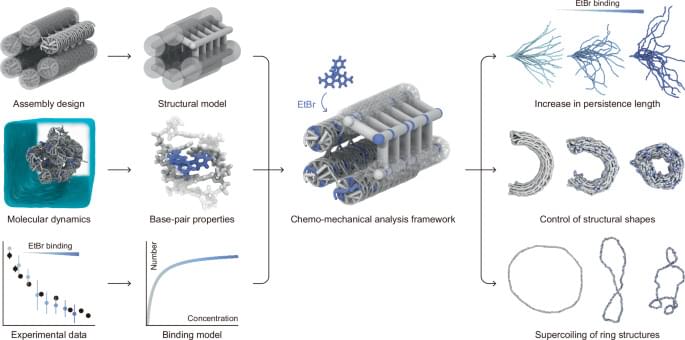New theoretical research finds that it’s impossible to form a black hole with the energy of light particles alone, poking a hole in Einstein’s theory of general relativity.


When two black holes collide, space and time shake and energy spreads out like ripples in a pond. These gravitational waves, predicted by Einstein in 1916, were observed for the first time by the Laser Interferometer Gravitational-Wave Observatory (LIGO) telescope in September 2015.

Chemo-mechanical deformation of structured DNA assemblies driven by DNA-binding ligands is promising for biological and therapeutic applications, but it is elusive how to effectively model and predict their effects on the deformation and mechanical properties of DNA structures. Here, the authors present a computational framework for simulating chemo-mechanical change of structured DNA assemblies, using ethidium bromide intercalation as an example.
An exploration of the newly discovered rock on Mars that seems to show tantalizing hints that it may be evidence of past microbial life living on Mars and how we may be very close to finally finding evidence of extraterrestrial life.
My Patreon Page:
/ johnmichaelgodier.
My Event Horizon Channel:
/ eventhorizonshow.
Music:

(CNN) — Regular aspirin use may keep the oncologist away, at least when it comes to colorectal cancer, according to a new study, and people with unhealthy lifestyles seemed to see the greatest benefit.
Colorectal cancer is the second most common cause of cancer death worldwide, predicted to cause more than 52,500 deaths in the US alone in 2023. About 153,020 people in the US were diagnosed with the condition in 2023, and it’s become much more prevalent among people under 55, with numbers more than doubling in this group from a decade ago, studies show.
The causes of colorectal cancer can be genetic, but certain lifestyle factors also seem to raise risk, including eating an unhealthy diet, not getting enough exercise, drinking alcohol, smoking and having a high body mass index.


Space weather is heating up in our current solar cycle peak.
By Clara Moskowitz & Matthew Twombly
Aurora sightings may become more common, and satellite communications and power grids could be disrupted, as solar activity peaks. Our nearest star is always volatile, but its magnetic action waxes and wanes on an 11-year loop. The sun is thought to be in a peak now, although scientists will need another year or two to analyze data before they can say for sure. During this high point we should see more sunspots (dark areas where the sun’s magnetic field reaches the surface) and solar storms (ejections of energy from the sun that reach into space and can affect Earth).

Innovative techniques being developed to detect gravitational waves beyond the current capabilities of laser interferometers like LIGO and Virgo.
That rare bright spot looks set to become brighter.
All of the more than 100 gravitational-wave events spotted so far have been just a tiny sample of what physicists think is out there. The window opened by LIGO and Virgo was rather narrow, limited mostly to frequencies in the range 100–1,000 hertz. As pairs of heavy stars or black holes slowly spiral towards each other, over millions of years, they produce gravitational waves of slowly increasing frequency, until, in the final moments before the objects collide, the waves ripple into this detectable range. But this is only one of many kinds of phenomenon that are expected to produce gravitational waves.
LIGO and Virgo are laser interferometers: they work by detecting small differences in travel time for lasers fired along perpendicular arms, each a few kilometres long. The arms expand and contract by minuscule amounts as gravitational waves wash over them. Researchers are now working on several next-generation LIGO-type observatories, both on Earth and, in space, the Laser Interferometer Space Antenna; some have even proposed building one on the Moon1. Some of these could be sensitive to gravitational waves at frequencies as low as 1 Hz.

Dark energy remains among the greatest puzzles in our understanding of the cosmos. In the standard model of cosmology called the Lambda-CDM, it is accounted for by adding a cosmological constant term in Einstein’s field equation first introduced by Einstein himself. This constant is very small and positive and lacks a complete theoretical understanding of why it has such a tiny value. Moreover, dark energy has some peculiar features, such as negative pressure and does not dilute with cosmic expansion, which makes at least some of us uncomfortable.

Using two optically trapped glass nanoparticles, researchers observed a novel collective Non-Hermitian and nonlinear dynamic driven by nonreciprocal interactions. This contribution expands traditional optical levitation with tweezer arrays by incorporating the so-called non-conservative interactions. Their findings, supported by an analytical model developed by collaborators from Ulm University and the University of Duisburg-Essen, were recently published in Nature Physics.
Understanding Nonreciprocal Interactions
Fundamental forces like gravity and electromagnetism are reciprocal, meaning two objects either attract or repel each other. However, for some more complex interactions arising in nature, this symmetry is broken and some form of nonreciprocity exists. For example, the interaction between a predator and a prey is inherently nonreciprocal as the predator wants to catch (is attracted to) the prey and the latter wants to escape (is repelled).